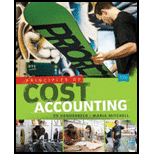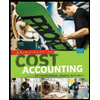
Concept explainers
1.
Prepare the flexible budget for the production levels of 80%, 90% and 110% of normal capacity and calculate the predetermined factory
1.
Explanation of Solution
Prepare the
| Factory overhead cost budget | |||
| Percent of normal capacity | 80% | 90% | 110% |
| Number of units | 8,000 | 9,000 | 11,000 |
| Number of standard direct labor hours | 24,000 | 27,000 | 33,000 |
| Budgeted factory overhead: | |||
| Fixed cost: | |||
| $ 1,800 | $ 1,800 | $ 1,800 | |
| Taxes on building and machinery | $ 750 | $ 750 | $ 750 |
| Insurance on building and machinery | $ 800 | $ 800 | $ 800 |
| Superintendent's salary | $ 4,400 | $ 4,400 | $ 4,400 |
| Supervisors' salaries | $ 6,200 | $ 6,200 | $ 6,200 |
| Maintenance wages | $ 1,500 | $ 1,500 | $ 1,500 |
| Total fixed cost | $ 15,450 | $ 15,450 | $ 15,450 |
| Variable cost: | |||
| Repairs | $ 480 | $ 540 | $ 660 |
| Maintenance supplies | $ 360 | $ 405 | $ 495 |
| Other supplies | $ 240 | $ 270 | $ 330 |
| Payroll taxes | $ 960 | $ 1,080 | $ 1,320 |
| Small tools | $ 480 | $ 540 | $ 660 |
| Total variable cost | $ 2,520 | $ 2,835 | $ 3,465 |
| Total factory overhead cost | $ 17,970 | $ 18,285 | $ 18,915 |
Table (1)
Calculate the predetermined factory overhead rate.
2.
Prepare the flexible budget for the production levels of 80%, 90% and 110% by assuming that the variable costs will differ in the portion to the change in volume with certain exceptions.
2.
Explanation of Solution
Prepare the factory overhead cost budget.
| Factory overhead cost budget | |||
| Percent of normal capacity | 80% | 90% | 110% |
| Number of units | 8,000 | 9,000 | 11,000 |
| Budgeted factory overhead: | |||
| Fixed cost: | |||
| Taxes on building and machinery | $ 750 | $ 750 | $ 750 |
| Insurance on building and machinery | $ 800 | $ 800 | $ 800 |
| Superintendent's salary | $ 4,400 | $ 4,400 | $ 4,400 |
| Total fixed cost | $ 5,950 | $ 5,950 | $ 5,950 |
| Semi variable cost: | |||
| Depreciation of building and machinery (1) | $ 1,800 | $ 1,800 | $ 1,950 |
| Supervisor’s salaries (2) | $ 6,200 | $ 6,200 | $ 8,450 |
| Maintenance wages (3) | $ 750 | $ 1,500 | $ 1,500 |
| Repairs (4) | $ 300 | $ 540 | $ 660 |
| Total semi variable cost | $9,050 | $10,040 | $12,560 |
| Variable cost: | |||
| Other supplies | $240 | $270 | $330 |
| Payroll taxes | $960 | $1,080 | $1,320 |
| Small tools | $480 | $540 | $660 |
| Maintenance supplies | $360 | $405 | $495 |
| Total variable cost | $2,040 | $2,295 | $2,805 |
| Total factory overhead cost | $17,040 | $18,285 | $21,315 |
Table (2)
Working note (1): Calculate the semivariable cost for depreciation of building and machinery for 110%.
Working note (2): Calculate the semivariable cost for supervisors’ salaries for 110%.
Working note (3): Calculate the semivariable cost for Maintenance wages for 80%.
Working note (4): Calculate the semivariable cost for repairs for 80%.
Want to see more full solutions like this?
Chapter 7 Solutions
Principles of Cost Accounting
- I need help with this general accounting problem using proper accounting guidelines.arrow_forwardPlease provide the accurate answer to this financial accounting problem using valid techniques.arrow_forwardCan you help me solve this financial accounting problem using the correct accounting process?arrow_forward
- I am looking for a reliable way to solve this financial accounting problem using accurate principles.arrow_forwardCan you solve this general accounting problem with appropriate steps and explanations?arrow_forwardPlease explain the solution to this general accounting problem with accurate explanations.arrow_forward
- Timothy Enterprises reported net sales of $5.75 million and beginning total assets of $1.80 million and ending total assets of $2.20 million. The average total asset amount is: a. $3.95 million b. $2.00 million c. $0.40 million d. $4.00 million e. $1.00 millionarrow_forwardCan you explain the correct approach to solve this general accounting question?arrow_forwardCrescent Motors had total assets of $720,000 and total liabilities of $430,000 at the beginning of the year. During the year, total assets decreased by $95,000, and stockholders' equity increased by $80,000. What is the amount of total liabilities at the end of the year?arrow_forward
- Wilson Manufacturing reported annual sales revenue of $4,250,000. During the year, accounts receivable decreased from a $95,000 beginning balance to a $75,000 ending balance. Accounts payable increased from a $60,000 beginning balance to a $90,000 ending balance. How much is cash received from customers for the year?arrow_forwardSimmons Corporation had their total liabilities decreased by $5,800 and stockholders' equity increased by $9,200 during a period of time. Then total assets must have changed by what amount and direction during that same period? HELParrow_forwardPlease provide the answer to this financial accounting question with proper steps.arrow_forward
 Principles of Cost AccountingAccountingISBN:9781305087408Author:Edward J. Vanderbeck, Maria R. MitchellPublisher:Cengage Learning
Principles of Cost AccountingAccountingISBN:9781305087408Author:Edward J. Vanderbeck, Maria R. MitchellPublisher:Cengage Learning Managerial Accounting: The Cornerstone of Busines...AccountingISBN:9781337115773Author:Maryanne M. Mowen, Don R. Hansen, Dan L. HeitgerPublisher:Cengage Learning
Managerial Accounting: The Cornerstone of Busines...AccountingISBN:9781337115773Author:Maryanne M. Mowen, Don R. Hansen, Dan L. HeitgerPublisher:Cengage Learning Cornerstones of Cost Management (Cornerstones Ser...AccountingISBN:9781305970663Author:Don R. Hansen, Maryanne M. MowenPublisher:Cengage Learning
Cornerstones of Cost Management (Cornerstones Ser...AccountingISBN:9781305970663Author:Don R. Hansen, Maryanne M. MowenPublisher:Cengage Learning Managerial AccountingAccountingISBN:9781337912020Author:Carl Warren, Ph.d. Cma William B. TaylerPublisher:South-Western College Pub
Managerial AccountingAccountingISBN:9781337912020Author:Carl Warren, Ph.d. Cma William B. TaylerPublisher:South-Western College Pub Financial And Managerial AccountingAccountingISBN:9781337902663Author:WARREN, Carl S.Publisher:Cengage Learning,Principles of Accounting Volume 2AccountingISBN:9781947172609Author:OpenStaxPublisher:OpenStax College
Financial And Managerial AccountingAccountingISBN:9781337902663Author:WARREN, Carl S.Publisher:Cengage Learning,Principles of Accounting Volume 2AccountingISBN:9781947172609Author:OpenStaxPublisher:OpenStax College





